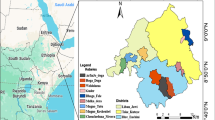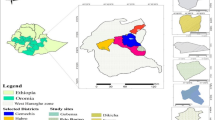Abstract
Black walnut (Juglans nigra) is an important tree species for temperate agroforestry in the United States for timber, nuts, wildlife, and abrasives. Predictions of forestland productivity are needed for proper species selection in tree planting. Potential productivity can be estimated for non-forested areas and agricultural croplands by relating site quality to site and soil characteristics. Our study measured the growth potential of black walnut in natural stands. We looked at over 210 stands on unglaciated soils in southeastern Kansas with the site index at 50 years ranging from 9.1 to 26.8 m. Numerous environmental factors were evaluated, including: site, soil chemical, and soil physical properties. These environmental factors were related to tree height at the standard age of 50 years. Simple correlation and multiple regression analyses were run with the site index using over 60 variables of soil and topographic characteristics. Understory competition had no effect on site index. Chemical characteristics had a slight effect on site index. We explained 73 % of the variation in site index with just two variables; depth to a restrictive layer (DRL) and soil type. DRL is a good predictor of walnut productivity.
Similar content being viewed by others
References
Ares A, Brauer D (2004) Growth and nut production of black walnut in relation to site, tree type, and stand condition in south-central United States. Agrofor Syst 63:83–90
Barr AJ, Goodnight JH, Sall JP, Helwig JT (1976) A user’s guide to SAS. SAS Institute, Inc, Raleigh, p 329p
Beers TW, Dress PE, Wensel LC (1967) Aspect transformation in site productivity research. J Forest 65:22–24
Bouvoucos GJ (1951) A recalibration of the hydrometer method for making mechanical analysis of soils. Agron J 43:432–437
Brinkman KA (1957) Silvical characteristics of black walnut. U.S. Forest Service Central States Forest Experiment Station. Miscellaneous publication. No. 22
Büsgen M, Münch E, Thomsom T (1929) The structure and life of forest trees. Chapman and Hall, London, p 300p
Carpenter SB, Hanover JW (1974) Comparative growth and photosynthesis of black walnut and honey locust seedlings. For Sci 20:317–324
Dennington RW (1989) Ripping can improve tree planting success. U. S. Forest Service Management Bulletin R8-MB 31
Garrett HE, Rieetveld, Fisher RF (2000) North American agroforestry: an integrated science and practice. American Society of Agronomy, Inc, Madison, p 402
Geyer WA, Marquard RD, Barber JF (1980) Black walnut site quality in relation to soil and topographic characteristics in northeastern Kansas. J Soil Water Conserv 35:135–137
Grey GW, Naughton G (1971) Ecological observations on the abundance of black walnut in Kansas. J For 69(10):741–743
Kalisz PJ, Stringer JW, Wells DB (1989) Growth of young black walnut plantations in Kentucky. Northern J Appl For 6(1):17–20
Kellogg LF (1939) Site index curves for plantation black walnut in the central states region. Forest Service, note no. 35. USDA Central States Forest Experiment Station, Columbus, OH
Losche CK, Clark WM, Voss EE, Ashley BS (1971) Guide to the selection of soil suitable for growing black walnut in Illinois. USDA Forest Service and USDA Soil Conservation Service, North Central Forest Experiment Station
Lucier AA, Hinckley TM (1982) Phenology, growth, and water relations of irrigated and non-irrigated black walnut. For Ecol Manage 4:127–142
Munn LC (1974) Predicting height growth of yellow-poplar from soils and topography on a Muskingum-Berks-Neotoma soils complex in southeastern Ohio. MS thesis. Ohio State University, Columbus, OH
Pham CH, Yen CP, Cox GS, Garrett HE (1977) Slope position, soil water storage capacity, and black walnut root development. In: Balmer WE (ed) Soil moisture-site productivity management symposium. USDA Forest Service, Southern Forest Experiment Station, Myrtle Beach, SC, pp 326–335
Spurway GW (1941) Soil reaction (pH) preferences for plants. Michigan Agricultural Experiment Station Bulletin 306. Michigan State University, East Lansing
Steinbrenner EC (1965) The influence of individual soil and physiographic factors on the site index of Douglas-fir in western Washington. In: Youngberg CT (ed) Forest soils relationships in North America. Oregon State University Press, Corvallis, pp 261–270
Stone EL, Kalisz PJ (1991) On the maximum extent of tree roots. For Ecol Manage 46:59–102
Thompson GW, McComb AL (1962) Growth of plantation black walnut in relation to pH and certain chemical factors of the soil. For Sci 8:322–333
USDA Forest Service (1980) Root characteristics of some important trees of eastern forests: a summary of the literature. USDA Forest Service, Eastern Region
Van Sambeek JW, McBride FD (1991) Grass control improves early growth of black walnut more than either deep ripping or irrigation. In: The 2nd conference on agroforestry in North America. Springfield, IL, August 1991. Association for Temperate Agroforestry, Columbia, MO, pp 42–57
Wallace DC, Young FJ (2008) Black walnut suitability index: a natural resources conservation service national soil information system based interpretive model. In: Michler CH (ed) Proceedings, 16th Central Hardwood Forest Conference, West Lafayette, Indiana, April 8–9, 2008. Gen Tech Rep NRS-P-24. USDA Forest Service, Northern Research Station, Newtown Square, pp 589–595
Wilde SA (1934) Soil relation to forestry, and its determination by simple tests. J Forest 32:415
Williams RD (1990) Juglans nigra L. black walnut. In: Burns RM, Honkala BH (technical coordinators) Silvics of North America. Agriculture Handbook 654. USDA, Washington, DC
Xu F (2000) Study on temporal processes of sloping agroforestry system. J Soil Water Conserv 14:46–50
Author information
Authors and Affiliations
Corresponding author
Additional information
Felix Ponder Jr., Research Soil Scientist—deceased.
Rights and permissions
About this article
Cite this article
Geyer, W.A., Ponder, F. Transferring site information for black walnut from native woodlands in southeastern Kansas USA to identify sites for agroforestry practices. Agroforest Syst 87, 13–18 (2013). https://doi.org/10.1007/s10457-012-9518-4
Received:
Accepted:
Published:
Issue Date:
DOI: https://doi.org/10.1007/s10457-012-9518-4




